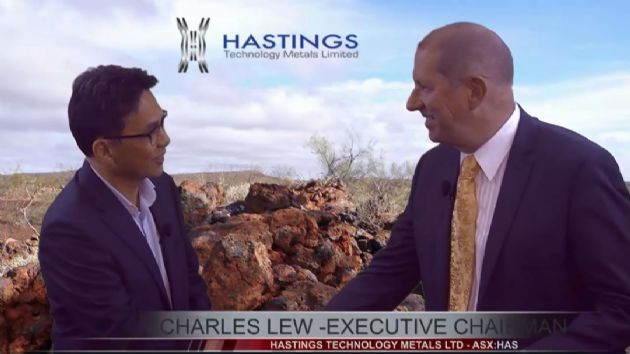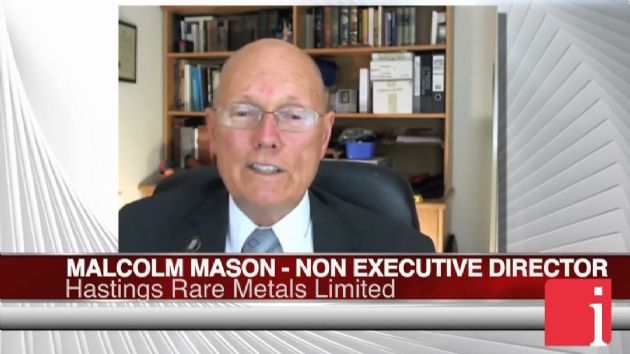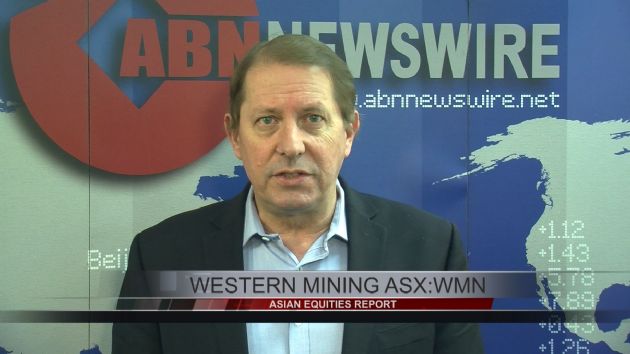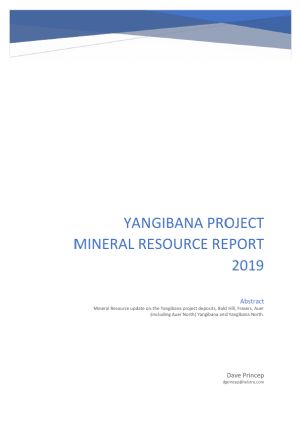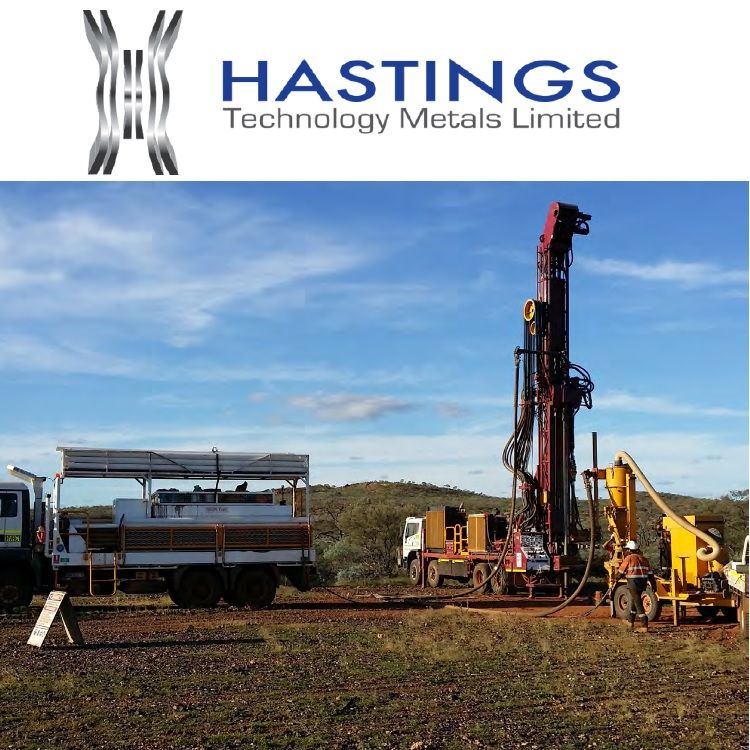
50% Increase in Yangibana Ore Reserves to 7.74 Million Tonnes
Sydney, July 31, 2018 AEST (ABN Newswire) - Hastings Technology Metals Limited ( ASX:HAS) is pleased to announce a significant increase in the Probable Ore Reserves at the Yangibana Project in the Gascoyne region of Western Australia. Total Probable Ore Reserves have increased to 7.74 million tonnes at 1.13%TREO including 0.43%Nd2O3+Pr6O11, a 50% increase on the figures established in November 2017 as part of the Company's Definitive Feasibility Study (DFS) and as reported in the ASX release entitled "Successful Completion of Yangibana Definitive Feasibility Study" dated 28th November 2017.
ASX:HAS) is pleased to announce a significant increase in the Probable Ore Reserves at the Yangibana Project in the Gascoyne region of Western Australia. Total Probable Ore Reserves have increased to 7.74 million tonnes at 1.13%TREO including 0.43%Nd2O3+Pr6O11, a 50% increase on the figures established in November 2017 as part of the Company's Definitive Feasibility Study (DFS) and as reported in the ASX release entitled "Successful Completion of Yangibana Definitive Feasibility Study" dated 28th November 2017.
- Probable Ore Reserves increased to 7.74 million tonnes at 1.13%TREO including 0.43%Nd2O3+Pr6O11
- Includes the maiden Probable Ore Reserves at Yangibana West, Yangibana, Auer and Auer North deposits, estimated using JORC Code guidelines (2012 Edition)
- These additional Ore Reserves confirm the eight-year mine life as described in the Company's Definitive Feasibility Study (DFS) of November 2017
- Drilling continuing to further increase Probable Reserves at Auer and Auer North
Probable Ore Reserves
Based on Pre-Feasibility studies (PFS) for recent geological, geotechnical, metallurgical and environmental work, independent consultants Snowden Mining Industry Consultants (Snowden) has completed PFS mining studies based on Measured and Indicated Mineral Resources at the Yangibana West, Yangibana, Auer and Auer North deposits. The mining focus is high ore recovery, and conventional drill and blasting methods will be employed.
The Modifying Factors used to estimate the Ore Reserves are provided in the Table 1 (see link below) Section 4 of the JORC Code (2012) at the end of this announcement. Mining at each of the deposits will encounter three main rock types:
- The upper horizon is a saprolite, this does not require blasting.
- The lower weathered and fresh granite horizons require blasting.
- Ironstone (not all of which is ore), RC grade control drilling is required.
The ore dips at between 10-45o and varies in thickness between 1m and 20m at Fraser's and 1m and 30m at Bald Hill, with an average thickness of 4m. At Yangibana West the ore dips at 20-40o and ranges to 5m thick. Ore at Yangibana is narrower at 2-3m and dips at 40-50o, and at Auer and Auer North it is steeper (70-80o) and averages around 3m wide.
The ore zone (generally ironstone) is visually distinct from the host rock, providing some visual control for ore identification. RC grade control drilling will be done, on a 10m x 10m grid, prior to ore delineation.
Well controlled blasting and mining near and in the ore zones is planned to minimise dilution and allow selective mining of the hanging-wall to expose and selectively mine the ore. Due to the high value of the ore, a high ore recovery is the focus of mining. As such, a 50cm skin of dilution is added to the ore mined to enable a 98% ore recovery assumption. This dilution was incorporated in the estimation of reserves at each deposit.
For pit optimisation a 28o overall wall angle was applied to the saprolite, and 35-40o to weathered and fresh granite. In addition to the 50cm skin applied during the resources estimation process, Snowden established waste dilution at 19% at Bald Hill, 14% at Fraser's, 32% at Yangibana West, 26% at Yangibana and 21% at Auer and Auer North. A 2% ore loss was also applied to each deposit.
Ground water at all deposits sits at around 45m below the mining surface. Pits will be dewatered ahead of mining using bores pumping a maximum 8 litres per sec pumped from each pit to provide a dewatered rock mass. Stormwater will be managed in pit using sumps with an estimated maximum of 10 litres per sec pumped from sumps in each pit.
Waste from each pit is stored in adjacent waste dumps. Some of the Bald Hill pit is backfilled to minimise haulage distances. Ore is transferred either directly to the Run-Of-Mine (ROM) pad, or to a low-grade stockpile, by mining trucks.
Pit optimisations were completed to determine the economic mining limits for each deposit. Only Measured and Indicated Resources were considered for processing. Pits were then designed in stages to enable higher grades to be targeted and waste extraction to be deferred.
Pit optimisation studies have defined the total Probable Ore Reserves for the Yangibana Project as shown in Table 1 (see link below) including these additional deposits.
The current resources at Auer and Auer North are shown in Tables 2 and 3 (see link below) as reported in the ASX release entitled "Final 2017 JORC Resource Update Including Auer and Auer North Results" dated 22nd November 2017.
The current resources at Yangibana are shown in Table 4 (see link below) as reported in the ASX release entitled "Yangibana Project Resources Now Exceed 20.5 Million Tonnes" dated 12th October 2017.
The current resources at Yangibana West are shown in Table 5 (see link below) as reported in the ASX release entitled "Another Major Increase In JORC Resources From Current Yangibana Drilling" dated 24th July 2017.
All Probable Ore Reserves are within tenements held 100% by Hastings, with all but those at Auer and Auer North being held under granted Mining Leases. The increased Ore Reserves support the eight-year mining and processing operation at 1.0 million tonnes per annum as described in the November 2017 DFS.
A major infill and extension drilling programme comprising both reverse circulation and diamond drilling is well advanced at Auer and Auer North aiming to increase estimates of Measured and Indicated Mineral Resources and thence reserves at these deposits.
Pre-Feasibility Study
The maiden Probable Ore Reserves at the Yangibana West, Yangibana, Auer and Auer North deposits are based on results of a supplementary Pre-Feasibility Study (PFS). Hastings undertook the PFS on these additional deposits, which are in addition to the Bald Hill and Fraser's deposits forming the Yangibana Rare Earths Project (the Project) in Western Australia.
The November 2017 Definitive Feasibility Study (DFS) detailed the Project, which will produce a Mixed Rare Earth Carbonate (MREC) rich in Neodymium (Nd) and Praseodymium (Pr), critical materials used in the manufacturing of permanent magnets. The DFS produced a maiden Ore Reserve for the Bald Hill and Fraser's deposits, which underpinned the first 5 years of mine life. The DFS also included an additional production target (APT) produced from the Yangibana West, Yangibana, Auer and Auer North deposits.
The APT satellite deposits were not included in the 2017 Ore Reserve estimate because the required geotechnical investigation had not yet been completed and consequently the mine design and mining cost estimates could not be developed to a PFS level. The required geotechnical drilling and analysis was then completed in Q2 2018 and mine designs were also completed. Metallurgical development was substantially completed in 2017, except for comminution test work and confirmation of the compatibility of the Yangibana West deposit with the DFS process plant flowsheet. This work has since been undertaken to the required pre-feasibility level.
The Project is comprised of significant deposits across the tenement holdings - Bald Hill, Fraser's, Yangibana West, Yangibana, Auer and Auer North - all 100% owned by Hastings (note that these areas mentioned herein represent approximately 50sqkm out of a total of 650sqkm of exploration tenure). In addition, Hastings holds a controlling 70% stake in other tenements held in a Joint Venture arrangement in the greater Yangibana area, although these have not been considered in this PFS study. These Joint Venture tenements may be readily developed as upside to increase the mine life of the Project in the future.
The 2017 DFS evaluated the development of the mine, process plant (incorporating beneficiation and hydrometallurgy) and supporting infrastructure. The Project is designed to mine 1 Million tpa of ore and a process plant that can produce up to 15,000t of Mixed Rare Earths Carbonate (MREC) per annum from the Bald Hill, Frasers, Yangibana West, Yangibana, Auer and Auer North deposits. The current Ore Reserves of 7.74 Million tonnes supports a mine life of 8 years.
Hastings has completed the following work on the site:
- Mapping,
- Rock chip sampling,
- Commissioned a major hyperspectral survey,
- Topographic and aerial photo surveys, and
- Aeromagnetic and radiometric survey and interpretation over the GCFC.
Seven phases of drilling - both reverse circulation and diamond drilling have been completed by Hastings, with each phase increasing the JORC resources of the various deposits and providing samples for metallurgical test work. With shallow mineralisation, mining will be conventional drill and blast and operated by a mining contractor.
The Company has completed extensive DFS testwork to define the metallurgy for the Yangibana project, culminating in pilot plant tests on a composite sample of material from Bald Hill and Fraser's. This testwork has defined a process route entailing crush, grind, flotation, acid bake with water leach and precipitation of a Mixed Rare Earths Carbonate. Further metallurgical PFS testwork has established that the ore from each of Yangibana West, Yangibana, Auer and Auer North is compatible with this processing route.
Approximately 1 million tonnes per annum of ore will be brought to the Run Of Mine (ROM) pad where the flowsheet process begins. Early stages of the processing of the ore comprise comminution and beneficiation. The resulting beneficiated concentrate is upgraded by 20 times from the ROM ore, as demonstrated through the DFS, to a 25% TREO concentrate. This concentrate is further processed downstream through a hydrometallurgical process that involves acid bake, water leaching, impurity removal and precipitation to produce up to 15,000 tpa of MREC. The MREC will contain up to 3,400 tpa of neodymium oxide (Nd2O3) + praseodymium oxide (Pr6O11) representing 41% of contained TREO.
The scope of work required for environmental approvals have been substantially completed and the Project is progressing through a Public Environmental Review (PER) level of assessment by both the State and Commonwealth Governments. Auer and Yangibana deposits will require additional approval considerations as a formality although environmental considerations in the PFS demonstrated no significant environmental issues that would preclude a future approval being issued by State and Commonwealth Governments.
The key Ore Reserve parameters developed from the supplementary PFS are shown in Table 6 in link below.
This PFS financial evaluation evaluates the production targets based only on the combined Bald Hill, Fraser's, Yangibana, Yangibana West, Auer and Auer North deposits that were upgraded through the DFS and this PFS to a Probable Ore Reserve of 7,742 Mt (DFS Production Target).
A summary of the Mineral Resources and their utilisation as Production Target in the financial evaluation is provided in Table 7 in link below.
The PFS financial model assumes an average long-term US$/A$ exchange rate of US$0.75 and uses price forecasts from 2017 to 2027 for rare earths prices from Argus Media, an independent provider of price information, market data and business intelligence for the global resource industry. Financial evaluation of the Probable Ore Reserves in the PFS results in the economic outcome shown in Table 8 below.
------------------------------------------------------Operating Life 8 years Net Present Value (NPV) A$499m Internal Rate of Return (IRR) 76% Payback Period 2.3 years ------------------------------------------------------
To view tables and figures, please visit:
http://abnnewswire.net/lnk/128MK476
About Hastings Technology Metals Ltd
 Hastings Technology Metals Ltd (ASX:HAS) (FRA:5AM) is advancing its Yangibana Rare Earths Project in the Upper Gascoyne Region of Western Australia towards production. The proposed beneficiation and hydro metallurgy processing plant will treat rare earths deposits, predominantly monazite, hosting high neodymium and praseodymium contents to produce a mixed rare earths carbonate that will be further refined into individual rare earth oxides at processing plants overseas.
Hastings Technology Metals Ltd (ASX:HAS) (FRA:5AM) is advancing its Yangibana Rare Earths Project in the Upper Gascoyne Region of Western Australia towards production. The proposed beneficiation and hydro metallurgy processing plant will treat rare earths deposits, predominantly monazite, hosting high neodymium and praseodymium contents to produce a mixed rare earths carbonate that will be further refined into individual rare earth oxides at processing plants overseas.
Neodymium and praseodymium are vital components in the manufacture of permanent magnets which is used in a wide and expanding range of advanced and high-tech products including electric vehicles, wind turbines, robotics, medical applications and others. Hastings aims to become the next significant producer of neodymium and praseodymium outside of China.
Hastings holds 100% interest in the most significant deposits within the overall project, and 70% interest in additional deposits that will be developed at a later date, all held under Mining Leases. Numerous prospects have been identified warranting detailed exploration to further extend the life of the project.
Brockman Project
The Brockman deposit, near Halls Creek in Western Australia, contains JORC Indicated and Inferred Mineral Resources, estimated using the guidelines of JORC Code (2012 Edition).
The Company is also progressing a Mining Lease application over the Brockman Rare Earths and Rare Metals Project.
Hastings aims to capitalise on the strong demand for critical rare earths created by the expanding demand for new technology products.
| ||
|





